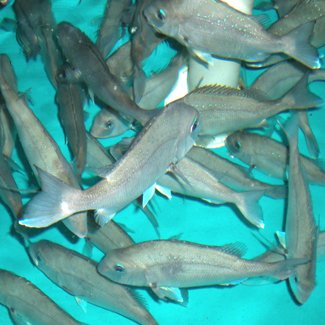Native fish swims 800km to find a mate

IN A MARATHON EFFORT to find a mate to breed, one native estuarine fish has clocked up an 800km swim.
The impressive long-haul journey was documented by researchers from Victoria’s Department of Sustainability and Environment who were using acoustic tags to monitor the behaviour of mulloway (Argyrosomus japonicus) in the state’s southwest.
The determined fish completed the largely oceanic swim – a round trip of about 800km, after it travelled from the Glenelg River estuary in Victoria, to the Murray Mouth in South Australia and back again, says Jason Lieschke, fish ecologist at the department’s Arthur Rylah Institute. None of the other 30 tagged specimens over the past two-and-a-half-year survey had strayed so far.
Record-breaking Australian fish
Jason says previous studies show fish often leave estuaries to breed, but they don’t usually cover such vast distances. “The fact that this one has moved 400km one way and 400km back again was pretty interesting,” he says.
The new information, he says, will help scientists to work out the best way to manage the conservation of mulloway, a popular recreational fishing species.
The survey showed that individual fish can swim up to 50km up and down the Glenelg River estuary in four days. It also reported one mulloway entering the Southern Ocean shortly before the river mouth closed up – forcing it to wait weeks for the river mouth to re-open so it could return home. Jason says he hopes these insights into the travelling habits of mulloway will be used to decide when the blocked river mouth should be manually opened.
“A lot of estuaries close from sand building up,” he says. “For the mulloway, which are moving in and out of the estuary every year, if it closes up at that time when they’re moving, and it’s going to restrict that population renewing itself.”
Recreational fishing species
The champion mulloway was only picked up so far from home because of an information-sharing partnership with a listening station at Coorong, South Australia. “[The scientists there are] also quite excited to see that these fish are turning up,” Jason says.
According to Dr Alistair Hobday from Marine and Atmospheric Research at the CSIRO, the sharing of tagging information and use of smaller and more sophisticated acoustic tags will deepen our understanding of the movement of different species Australia-wide.
“A lot of researchers are using the acoustic receivers in different parts of the country, and we’re starting to pick up each other’s fish,” he told Australian Geographic. “That sharing of tagged information is giving us new insight into really long distance movement.”
Southern blue fin tuna
For example, the CSIRO is currently wrapping up a project monitoring southern blue fin tuna on their migration from the Great Australian Bight to the Indian Ocean. They found that the fish were travelling much further south of fishing grounds than previously believed.
In North America, The Pacific Ocean Shelf Tracking project uses acoustic tagging to keep tabs on the journeys taken by young salmon and other migratory species. Over 3000km of the Pacific Coast of North America is ‘wired up’ with acoustic receivers that have an estimated capacity to pick up thousands of tags at any one time.
Migration, movement and behaviour of Australian marine species such as the great white shark, squid, cuttlefish and seals – and freshwater species such as the Murray cod and golden perch – have all been monitored this way.
RELATED STORIES

